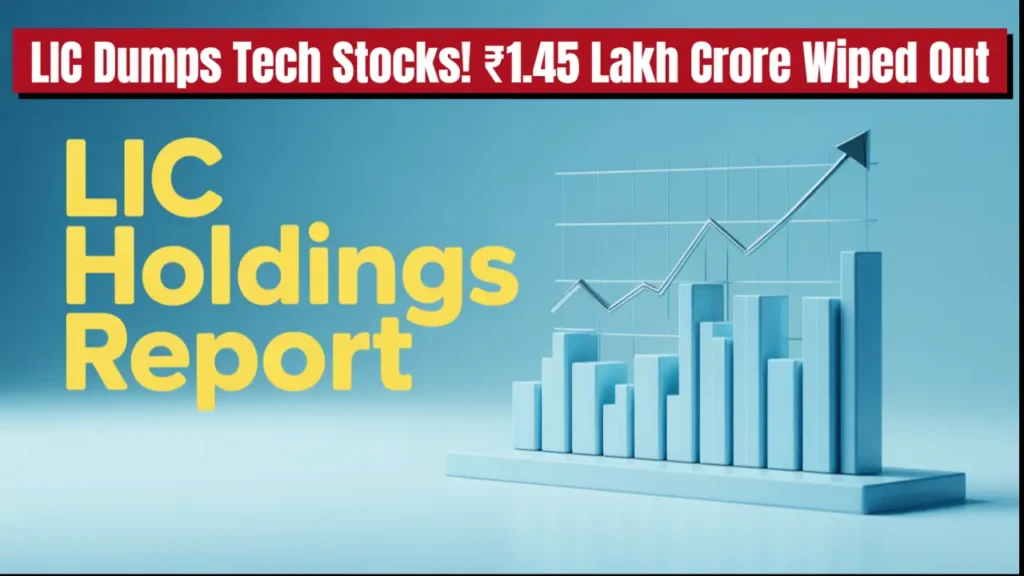India’s largest institutional investor, Life Insurance Corporation of India (LIC), has significantly reduced its equity exposure over recent quarters. As of Q3 FY25 (ended December 2024), LIC’s aggregate equity holding in NSE-listed companies dropped to a record low of 3.51%, according to regulatory filings.
This move is part of LIC’s broader profit-booking and risk management strategy. The insurer cut its stake in 98 companies, while increasing it in only 71 companies, indicating a defensive shift amid heightened market uncertainty.
By early 2025, the insurer’s mark-to-market equity portfolio value fell sharply—from ₹14.9 lakh crore in December 2024 to around ₹13.4 lakh crore in February 2025. That’s a massive ₹1.45 lakh crore erosion (approximately 5.7%) in just two months, largely driven by a broader market correction.

Sharp decline in major holdings of LIC
The value decline was led by sharp price drops in LIC’s major holdings, especially in blue-chip names. Key contributors to the fall include:
- ITC: Loss of ₹17,000 crore
- TCS and Infosys: Combined loss of ₹10,500 crore
- SBI: Loss of ₹8,500 crore
Other major laggards included Jio Financial Services, HCL Technologies, L&T, Adani Ports, and JSW Energy, each contributing significantly to the drop in overall valuations.
These declines affected not just LIC’s books but also investor confidence in large-cap stocks, many of which are widely held in mutual funds and retirement portfolios.
Strategic Portfolio Shift in Q4 FY25
In response, LIC launched a major portfolio reshuffle during Q4 FY25 (ending June 2025). The insurer reduced stakes in 81 companies, while increasing exposure to PSU defence firms—marking a strategic shift toward government-backed, stable sectors.
Notably, LIC participated in a major Qualified Institutional Placement (QIP) for State Bank of India, investing ₹5,000 crore to increase its stake from 9.21% to 9.49%.
It also raised its holdings in:
- Reliance Industries
- Tata Motors
- Patanjali Foods
Meanwhile, it trimmed positions in high-volatility names like:
- ICICI Bank
- Infosys
- TCS
- Bajaj group companies
This suggests a clear pivot away from cyclical and tech-heavy sectors and a renewed focus on more predictable and government-aligned sectors like defence, energy, and public sector banks.
Outlook: Rebalancing for Stability and Long-Term Growth
Despite the recent volatility, LIC shares are still trading slightly above their 52-week lows. Analysts are forecasting a potential 20–25% upside over the next 12 months, with price targets ranging between ₹825 and ₹1,320, assuming the market stabilizes.
This deliberate reduction in equity exposure and repositioning toward safer assets appears to be part of a calculated risk-management approach.
By minimizing holdings in tech and finance—which are more sensitive to global economic swings—and leaning into PSU sectors, LIC is likely trying to safeguard policyholder funds and reduce short-term volatility in its balance sheet.
Analyst Viewpoint:
While this portfolio rotation may provide protection in the near term, future performance will depend heavily on timing, sectoral picks, and broader macroeconomic recovery. Volatility may persist, but LIC’s rebalancing could position it well for long-term growth once earnings across sectors begin to stabilize.
F.A.Q.
– Why did LIC reduce its equity holdings in Q3 FY25?
LIC reduced its equity holdings as part of a profit-booking and risk management strategy, responding to high market volatility and falling valuations in key sectors like tech and finance.
– How much did LIC’s portfolio value decline by early 2025?
LIC’s mark-to-market portfolio value fell from ₹14.9 lakh crore in December 2024 to ₹13.4 lakh crore in February 2025, representing a decline of ₹1.45 lakh crore or about 5.7%.
– Which major stocks led to LIC’s portfolio losses?
LIC saw major losses from top holdings such as ITC (₹17,000 crore), TCS and Infosys (₹10,500 crore combined), and SBI (₹8,500 crore). Other draggers included HCL Tech, L&T, Adani Ports, and JSW Energy.
– What changes did LIC make in Q4 FY25 to its portfolio?
In Q4, LIC cut stakes in 81 companies and increased investments in PSU defence stocks, Reliance Industries, Tata Motors, and Patanjali Foods. It also bought shares in State Bank of India via a ₹5,000 crore QIP.
– What’s the outlook for LIC shares and investment strategy?
Analysts expect a 20–25% upside in LIC shares over the next 12 months. The shift toward public sector and defensive sectors may help stabilize returns amid market turbulence.
Also read:-